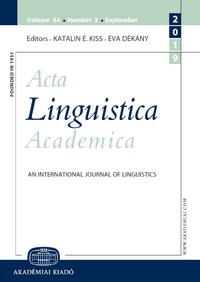Positional factors in syllabification
Positional factors in syllabification
Author(s): Diana PassinoSubject(s): Phonetics / Phonology
Published by: Akadémiai Kiadó
Keywords: syllable theory; consonant clusters; syllabification; fortition; complex segments; strong position
Summary/Abstract: From the perspective of standard generative phonological theory, syllable structure is not recorded in the lexicon but it is obtained by means of a syllabification algorithm based on a series of principles. In a given language, the algorithm should parse obstruent+liquid clusters as tautosyllabic both in word-initial and word-internal positions. The tautosyllabic parse as a branching onset complies with all principles on which the syllable-building algorithm is based. In standard theory, if branching onsets of obstruent+liquid are allowed in a language and documented in word-initial position, tautosyllabic parse is predicted to hold also word-internally. Likewise, Kaye’s (1992) Uniformity Principle makes the same prediction, since it states that sequences of contiguous positions that are in a governing relation and contain the same phonological material have the same constituent structure. The present paper draws attention to empirical data showing obstruent+liquid clusters being parsed tautosyllabically in word-initial position and heterosyllabically in word-internal position in the same language. An account is proposed to explain the data discussed, claiming that positional factors may also be relevant in determining syllabification.
- Issue Year: 67/2020
- Issue No: 1
- Page Range: 91-108
- Page Count: 18
- Language: English
- Content File-PDF

